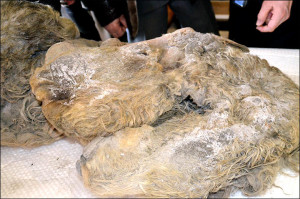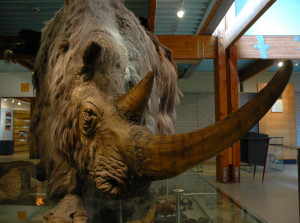Updated on: 21/05/2024
The Wooly rhino is an extinct rhinoceros species lived during the Pleistocene epoch. The appearance of this species is known from cave paintings and mummified individuals found in its native range. Several fossil specimens were found in Siberia, with the latest being in 2007.
Scientists believe that they appeared around 350000 years ago and survived the last glacial period (i.e. the Ice Age; 10000 years ago). However, recent radiocarbon dating suggests that the Woolly rhinos lived as recently as 8000 BC in West Siberia, though the accuracy of this date is not certain. Their extinction co-occurred with the minor climatic changes that took place for around 1000 – 1250 years after the Ice Age. Many Pleistocene megafauna species went extinct around the same time.
| Kingdom: | Animalia |
| Phylum: | Chordata |
| Class: | Mammalia |
| Order: | Perissodactyla |
| Family: | Rhinocerotidae |
| Genus: | Coelodonta |
| Species: | C. antiquitatis |
| Binomial Name: | Coelodonta antiquitatis |

The Woolly rhino was found throughout Northern Asia and parts of Europe. Their distribution extended from Scotland to Spain to as far as South Korea. Researchers believe that the Woolly rhino had the largest known range of any rhino species (alive or extinct) in the latter part of the Pleistocene epoch. However, the population could never extend their range to North America by moving across the Bearing Strait. Their fossil remains are often found across its historic range in Asia and Europe.

The Woolly rhino was the last and most derived member of Pleistocene rhinoceros descent. Even though the Woolly rhino was specialized for extreme cold weather, yet they were capable of dealing with warmer climates. The thick woolly pelage and compact limbs made them well suited to the steppe-tundra surrounding prevalent throughout the Palearctic ecozone during the Pleistocene glaciations.
They used their horns for defensive purposes; and also to attract females during the mating season. This species wandered the Doggerland and most of the Northern Europe. The alternative warm and cold seasons also forced them to migrate and expand their range. The habitat of Woolly Rhino also supported other grazing herbivores like Woolly mammoth, Bison and Wild horses.
The palaeodiet of the woolly rhinoceros has been a matter of controversy. Researchers have found both browsing and grazing modes of eating habit. They used to feed on grass, leaves, twigs, shrubs, lichens, mosses and other vegetation.

Climate change and hyperdisease falls among the theories associated with the extinction of Woolly rhino. However, the main reason is believed to be hunting by the human. As they were adapted to expreme conditions, climate change could not the primary reason for which they went extinct. Other cold-adapted species like muskox, wisent, reindeer and others survived this time that backs the ‘overhunting’ hypothesis.